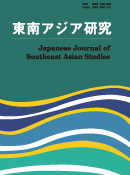Volume 15, Issue 3
Displaying 1-16 of 16 articles from this issue
- |<
- <
- 1
- >
- >|
Special Issue
Comemorative Volume for Professor Takeshi Motooka's Retirement
-
Article type: Article
1977Volume 15Issue 3 Pages 263-294
Published: 1977
Released on J-STAGE: June 02, 2018
Download PDF (2749K) -
Article type: Article
1977Volume 15Issue 3 Pages 295-306
Published: 1977
Released on J-STAGE: June 02, 2018
Download PDF (1052K) -
Article type: Article
1977Volume 15Issue 3 Pages 307-333
Published: 1977
Released on J-STAGE: June 02, 2018
Download PDF (3776K) -
Article type: Article
1977Volume 15Issue 3 Pages 334-346
Published: 1977
Released on J-STAGE: June 02, 2018
Download PDF (1262K) -
Article type: Article
1977Volume 15Issue 3 Pages 347-361
Published: 1977
Released on J-STAGE: June 02, 2018
Download PDF (1426K) -
Article type: Article
1977Volume 15Issue 3 Pages 362-383
Published: 1977
Released on J-STAGE: June 02, 2018
Download PDF (1718K) -
Article type: Article
1977Volume 15Issue 3 Pages 384-397
Published: 1977
Released on J-STAGE: June 02, 2018
Download PDF (1359K) -
Article type: Article
1977Volume 15Issue 3 Pages 398-420
Published: 1977
Released on J-STAGE: June 02, 2018
Download PDF (1834K) -
Article type: Article
1977Volume 15Issue 3 Pages 421-429
Published: 1977
Released on J-STAGE: June 02, 2018
Download PDF (838K) -
Article type: Article
1977Volume 15Issue 3 Pages 430-441
Published: 1977
Released on J-STAGE: June 02, 2018
Download PDF (1135K) -
Article type: Article
1977Volume 15Issue 3 Pages 442-451
Published: 1977
Released on J-STAGE: June 02, 2018
Download PDF (859K) -
Article type: Article
1977Volume 15Issue 3 Pages 452-456
Published: 1977
Released on J-STAGE: June 02, 2018
Download PDF (466K) -
Article type: Article
1977Volume 15Issue 3 Pages 457-471
Published: 1977
Released on J-STAGE: June 02, 2018
Download PDF (1844K) -
Article type: Article
1977Volume 15Issue 3 Pages 472-478
Published: 1977
Released on J-STAGE: June 02, 2018
Download PDF (873K) -
Article type: Appendix
1977Volume 15Issue 3 Pages 479-486
Published: 1977
Released on J-STAGE: June 02, 2018
Download PDF (681K) -
Article type: Appendix
1977Volume 15Issue 3 Pages 487-492
Published: 1977
Released on J-STAGE: June 02, 2018
Download PDF (376K)
- |<
- <
- 1
- >
- >|
